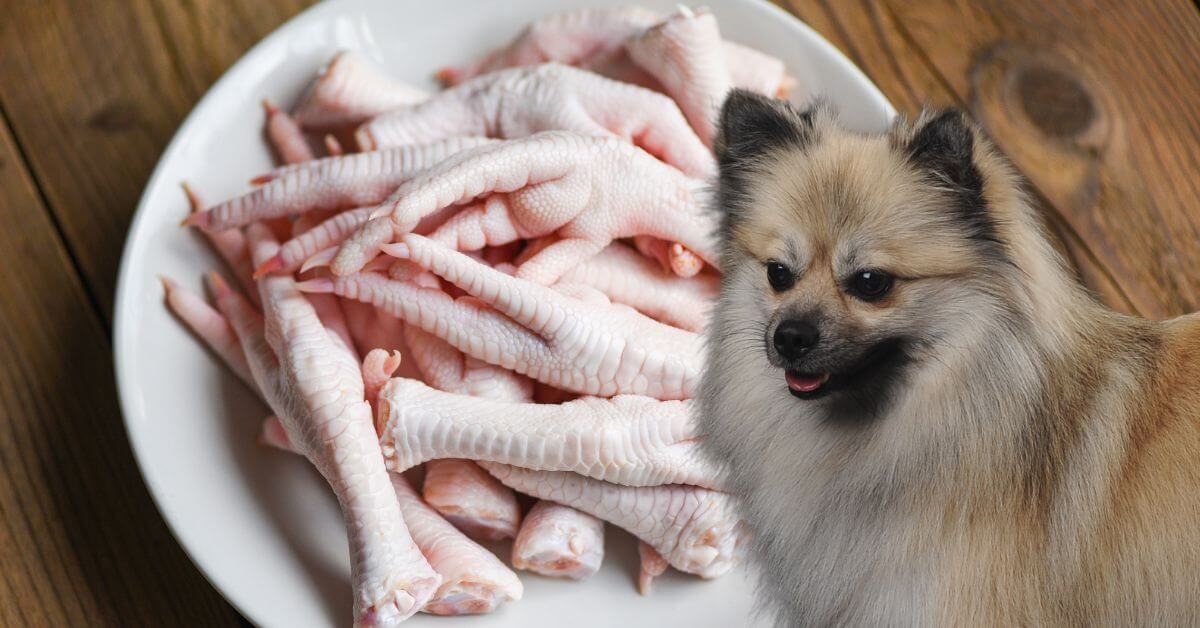Can dogs eat chicken feet?
This is a very complex question, and the answer is even more complex! Dogs can technically eat chicken feet, but it really depends on whether they’re raw, cooked, boiled, dried, smoked, or puffed! There are so many options here, and we’re gonna break them down by prep method and list pros and cons. Please remember to talk to your vet before introducing chicken feet to your dog’s diet. Eating bones is not necessary for your dog’s health, and you should only give them as a special treat with caution.

We struggled with this topic quite a lot (you can read more about our story on our About Us page), and we talked to several vets about this topic. Most said – don’t give Ricco chicken feet. The main reason is that pizzles are a better treat; he’s very small, super crazy sometimes about his treats, and there’s a choking hazard when it comes to bones. However, they didn’t say that chicken feet are not meant for dogs; it’s just that knowing Ricco, they said no. We have two vets, one that we see twice yearly where he gets his shots, and one just around the corner where we go for nail trimming and emergencies. They both know him well, and we trust them. But all dogs are different, and maybe your dog has better discipline when chewing (Ricco doesn’t like to chew his food). So we’ll share everything they told us about this topic! We also wrote a comprehensive guide about feeding dogs chicken meat, so check that out!
Can dogs eat raw chicken feet?
It turns out that raw chicken feet are safe for dogs if you shop organically or from a trusted supplier. You need to make sure that meat doesn’t have Salmonella which can be dangerous for dogs.
Why it’s safe?
It would be best if you watched out for:
Pet owners generally think that feeding raw chicken feet to dogs is generally, but there are some important things you have to know so you can calculate the risk:
We must add that even the FDA warns against feeding your dog a raw diet, so please consider this!
How do dogs digest bones, and what if they get stuck?
We’ll use this opportunity to tell you more about a study on bones as foreign bodies in dogs.
This study looked at what happens when dogs swallow bones that get stuck in their esophagus (throat) or stomach. It turns out that these situations are quite common, especially since many dogs love to chew on bones. The researchers reviewed 129 cases of dogs with bone foreign bodies—45 in the esophagus and 84 in the stomach.
For bones stuck in the esophagus, most were safely removed without surgery, either by pulling them out with an endoscope or pushing them into the stomach. However, if the bones were stuck for a long time or lodged in the lower part of the esophagus, there was a higher chance of causing injury. In a few cases, surgery was needed.
Bones in the stomach were mostly left to dissolve naturally, and this approach had no reported complications. Endoscopic removal was only needed when the dogs showed signs of distress or if the bones were relatively large. The study found that leaving bones in the stomach to dissolve can be a safe option, avoiding the need for more invasive procedures.
In short, while esophageal bones need prompt removal to avoid injury, stomach bones can often be left to break down naturally. This research helps vets decide the best and safest treatment for dogs who get into a bit of a bone-related pickle. Hope this information will help you decide whether or not to feed your dog chicken feet!
Can puppies eat raw chicken feet?
Puppies can eat raw chicken feet, and many people give them them instead of chewing toys. Raw chicken feet are soft and brittle, making them easier for puppies to chew on without the risk of splintering into sharp pieces like cooked bones do. Chewing on raw chicken feet helps soothe teething pain and keeps puppies engaged, promoting healthy chewing habits.
Can dogs eat frozen chicken feet?
Yes, dogs can eat frozen chicken feet. Frozen chicken feet retain all the nutritional benefits of raw chicken feet, including high levels of glucosamine and chondroitin, and both are great for joint health. The freezing process keeps their nutritional value high.
Benefits of chicken feet for dogs
Chicken feet are a tasty dog treat and offer several health benefits. Here are some key benefits:
How chewing chicken feet can help with the dental health of dogs
Dental health is very important for dogs, and chewing on chicken feet can help with it. Here’s how chicken feet contribute to your dog’s dental hygiene:
Can dogs eat dehydrated (dried) chicken feet?
Yes, dogs can safely eat dried or dehydrated chicken feet, as they are made specifically for dogs. Chicken feet come in two forms – dehydrated and puffed – and both are perfectly safe for dogs because they are not cooked.
Why it’s safe?
It would be best if you watched out for:
Dehydrated and Puffed Chicken Feet
Dehydrated chicken feet are made by drying them in a dehydrator at low temperatures, typically around 120-140°F. This method helps seal in the flavor and nutrients, so that’s why dogs love them. Puffed chicken feet, on the other hand, are air-dried. This process retains more vitamins and nutrients and helps maintain their natural shape.
It’s important to understand that cooked, boiled, or fried chicken bones can be dangerous for dogs. The high cooking temperatures make these bones hard and prone to splintering, which can cause serious injuries. However, because dehydrated and puffed chicken feet are dried rather than cooked, their bones will crush and crumble safely, making them fully digestible for your dog. Dehydrated and puffed chicken feet are safe for dogs if your dog knows how to eat them! They have good nutrients, support joint and dental health, and are a natural, eco-friendly treat.

Can dogs eat cooked or boiled chicken feet
Dogs should not eat boiled or cooked chicken feet. While chicken feet are generally safe and healthy for dogs when dried or dehydrated, boiling or cooking them can make them dangerous. The high temperatures used in boiling or cooking cause the bones in the chicken feet to become hard and brittle, similar to glass. When dogs chew on these cooked bones, they can splinter and shatter easily, leading to severe injuries. These splinters can cause punctures or tears in the mouth, throat, or intestines, resulting in serious health complications or even requiring emergency surgery.
In contrast, dried or dehydrated chicken feet are safe because the drying process makes the bones crushable and digestible. The drying process also preserves glucosamine and chondroitin, which are beneficial for joint health. Cooking, on the other hand, can destroy these essential nutrients, making boiled or cooked chicken feet not only unsafe but also less beneficial for your dog’s health.
Moreover, cooked chicken feet lose their natural flavor and texture, which can make them less appealing to dogs. The crunchy, chewy texture of dried or dehydrated chicken feet is what makes them such a popular treat among dog owners. This texture helps scrape off plaque and tartar from your dog’s teeth, promoting better dental hygiene. Boiling or cooking removes this benefit and turns a nutritious snack into a potentially harmful one.
If you want to give your dog chicken feet, it’s best to stick to dehydrated or puffed versions, which are safe and provide some health benefits. Always avoid giving your dog any cooked bones, including cooked chicken feet, to prevent any risk of injury or health issues. Still, if you’re scared and don’t want to risk (like we do), choose other eco friendly dental treats and then you don’t have to worry.
Love, life and fur forever!
FAQs
Can dogs eat boiled chicken feet?
No, dogs should not eat boiled chicken feet. The high cooking temperatures make the bones hard and brittle, which can splinter and cause serious injuries or gastrointestinal perforation.
Can dogs eat frozen chicken feet?
Yes, dogs can eat frozen chicken feet. They are safe and can provide a refreshing treat, especially on hot days. Just make sure you’re okay with this, you’ve talked to your vet and that you’ll supervise your dog to prevent choking.
Can dogs eat dried chicken feet?
Yes, dogs can eat dried chicken feet. The drying process makes the bones crushable and digestible, making them a safe and nutritious treat. However, always supervise your dog while they chew.
Can dogs eat cooked chicken feet?
No, dogs should not eat cooked chicken feet. Cooking makes the bones brittle and prone to splintering, which can lead to severe injuries and digestive issues.
Can dogs eat raw chicken feet with nails?
Yes, dogs can eat raw chicken feet with nails. The nails are usually safe, but if you feel uncomfortable, you can clip them off before feeding. Make sure that the raw chicken feet are from a reputable source to avoid bacteria like Salmonella.